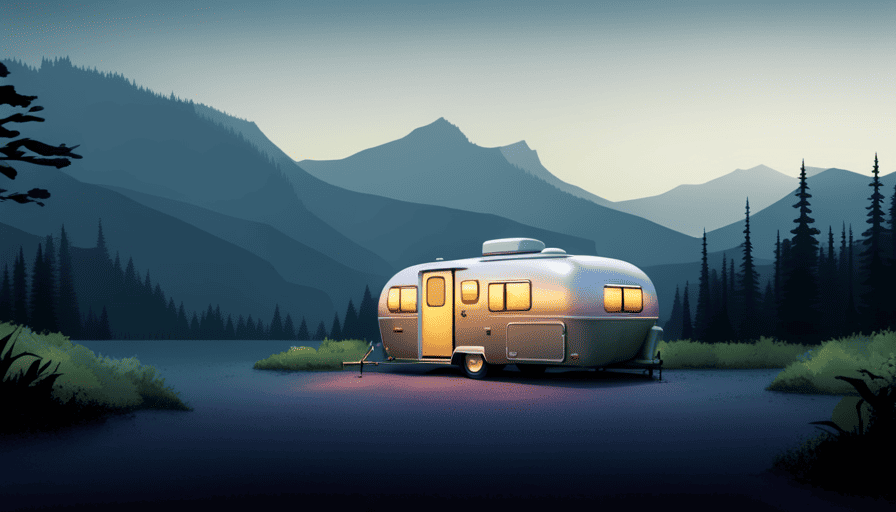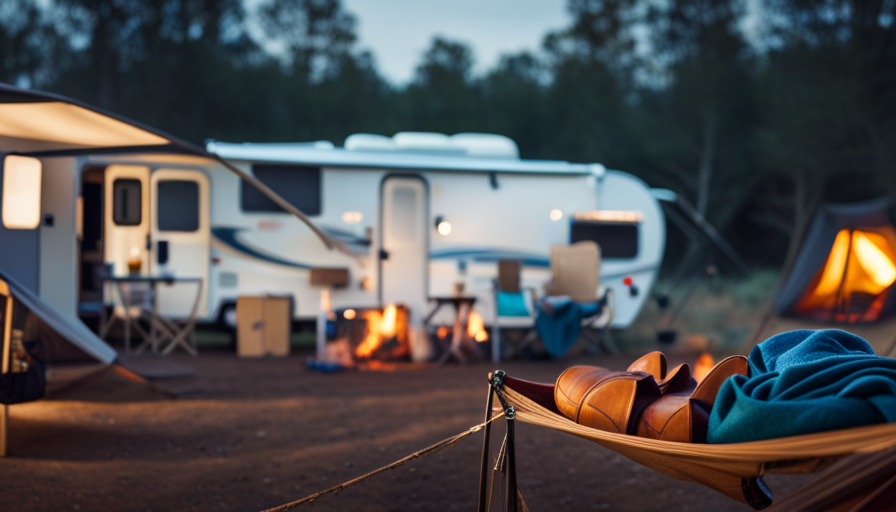Have you ever experienced the frustration of being on a camping trip, only to discover that your RV battery won’t charge when plugged in? It’s like having all the ingredients for a delicious meal, but not having any way to cook it.
Well, fear not, because in this article, I will guide you through the troubleshooting process to help you get your camper battery up and running again.
First things first, we need to check the power connection. Is the plug securely inserted into the power source? Sometimes a loose connection can prevent the battery from charging properly.
Next, inspect the battery terminals. Are they clean and free from corrosion? Corroded terminals can disrupt the charging process.
If these steps don’t solve the issue, we’ll move on to testing the battery charger, checking the fuse, examining the battery cables, and verifying the battery voltage.
Additionally, we’ll explore the converter/inverter and consult the camper manual for further guidance.
And if all else fails, it may be time to seek professional assistance.
So, let’s dive in and unravel the mystery behind your camper battery not charging when plugged in.
Key Takeaways
- Properly inspect and clean battery terminals and connections to ensure optimal electricity flow.
- Verify battery voltage with a multimeter to determine if it is fully charged or discharged.
- Troubleshoot the inverter and converter for potential issues with the charging system.
- Consult the camper manual for detailed troubleshooting steps and seek professional assistance if needed.
Check the Power Connection
Check if you’re securely plugged in and make sure the power connection isn’t loose or damaged. This is the first step in troubleshooting common issues with a camper battery not charging when plugged in. Start by examining the power cord and the outlet you’re connected to. Check for any signs of damage, like frayed wires or bent prongs. Ensure that the cord is securely plugged into both the camper and the power source. Sometimes, a loose or faulty connection can prevent the battery from charging properly.
If the power connection appears to be in good condition and securely plugged in, the next step is to inspect the battery terminals. However, before moving on, it’s important to note that if you’re using an external charging source, such as a generator or solar panel, you should also check their connections and ensure they’re functioning properly.
Now, let’s move on to inspecting the battery terminals and exploring further troubleshooting steps.
Inspect the Battery Terminals
Take a peek at the little metal connectors on the ends of those power cables. Inspecting the battery terminals is an important step in troubleshooting common camper battery issues. These terminals are where the power from the charger is transferred to the battery, so any issues here could prevent the battery from charging properly.
Here are three things to look for when inspecting the battery terminals:
-
Corrosion: Check for any white or greenish build-up on the terminals. Corrosion can disrupt the flow of electricity and prevent the battery from charging effectively. If you spot corrosion, clean the terminals using a mixture of baking soda and water.
-
Loose connections: Ensure that the terminals are securely fastened to the battery. Loose connections can cause intermittent charging or no charging at all. Tighten any loose connections with a wrench or pliers.
-
Damage: Inspect the terminals for any signs of damage, such as cracks or bent metal. Damaged terminals may need to be replaced to ensure proper charging.
By inspecting the battery terminals for corrosion, loose connections, and damage, you can troubleshoot common camper battery issues and ensure the charging system is functioning correctly. Now, let’s move on to the next step and test the battery charger.
Test the Battery Charger
Make sure you’ve got your hands on a multimeter, because it’s time to see if that battery charger of yours is doing its job. When troubleshooting charging issues with a camper battery, testing the battery charger is an essential step. A faulty charger can prevent the battery from charging properly, and it’s important to identify any common battery charger problems.
To begin, connect the multimeter to the battery charger by attaching the positive (red) probe to the positive terminal and the negative (black) probe to the negative terminal. Set the multimeter to the DC voltage mode and check the voltage reading. A working charger should provide a voltage within the manufacturer’s specified range.
If the voltage reading is zero or significantly lower than the specified range, there may be an issue with the charger. Common problems include a blown fuse, defective internal components, or faulty wiring. Inspect the charger for any visible signs of damage or loose connections.
Testing the battery charger is an important step in troubleshooting charging issues. By using a multimeter and checking the voltage output, you can identify common battery charger problems that may be preventing your camper battery from charging properly. Now, let’s move on to the next step and check the fuse.
Check the Fuse
To ensure a smooth charging process, you should promptly inspect the fuse for any signs of damage or wear. The fuse is a critical component in the charging system of your camper battery, and any issue with it can prevent the battery from charging properly. By troubleshooting this step, you can easily identify and resolve common issues that may be causing the charging problem.
To help you understand the importance of checking the fuse, let’s take a closer look at a table that outlines the troubleshooting steps and common issues related to the fuse:
| Troubleshooting Steps | Common Issues |
|---|---|
| Check the fuse for any signs of damage or wear | Blown fuse |
| Replace the fuse if necessary | Loose connection |
| Test the charger with a different fuse | Faulty fuse holder |
By following these steps and addressing the common issues, you can eliminate the fuse as a potential cause of the charging problem. This will allow you to move on to the next step, which is examining the battery cables and connections to ensure they are in good condition.
Examine the Battery Cables
Now, let’s check out the condition of your battery cables to make sure they’re in good shape. Did you know that loose or corroded battery cables can account for up to 70% of starting problems in vehicles? It’s important to regularly inspect your battery cables for any signs of damage or wear. Here are five key points to consider when performing battery cable maintenance:
-
Look for loose connections: Make sure that the battery cables are securely attached to the battery terminals. Loose connections can prevent the battery from charging properly.
-
Check for corrosion: Corrosion can build up on the battery terminals and cable ends, hindering the flow of electricity. Clean any corrosion using a wire brush and apply a corrosion-resistant spray.
-
Inspect for fraying or damage: Inspect the battery cables for any signs of fraying, cracking, or other damage. Damaged cables should be replaced immediately to ensure proper charging.
-
Ensure proper cable routing: Make sure that the battery cables are routed correctly and aren’t being pinched or obstructed by any other components. Improper routing can lead to charging issues.
-
Tighten any loose connections: If you find any loose connections during the inspection, tighten them using a wrench or pliers.
By properly maintaining your battery cables, you can prevent common battery charging issues and ensure that your camper battery charges effectively.
Now, let’s move on to the next section on how to clean the battery connections.
Clean the Battery Connections
After inspecting your battery cables, it’s time to clean the connections and ensure optimal electricity flow. Battery maintenance is vital for a camper’s electrical system to function properly. Cleaning the battery connections is one of the most effective troubleshooting techniques to address a camper battery not charging when plugged in.
To begin, make sure to disconnect the battery from any power source before proceeding. Start by removing the battery cables from the terminals. Inspect the terminals for any signs of corrosion, such as white or greenish deposits. Corrosion can impede the flow of electricity, causing charging issues. If corrosion is present, mix a solution of baking soda and water and use a wire brush to gently scrub the terminals and cables. Rinse with clean water and dry thoroughly.
Next, apply a thin layer of petroleum jelly or dielectric grease to the cleaned terminals. This will help prevent future corrosion and promote better conductivity. Reattach the battery cables, ensuring they are securely tightened.
By cleaning the battery connections, you eliminate any potential barriers to electricity flow and increase the likelihood of a successful charge. Now, it’s time to verify the battery voltage to further diagnose the issue.
Verify the Battery Voltage
Don’t even bother checking the battery voltage, because who needs a functioning electrical system anyway? But if you do want to troubleshoot the issue of your camper battery not charging when plugged in, it’s important to verify the battery voltage.
This step will help you determine if the battery is capable of holding a charge and if it’s receiving a proper charge from the power source.
To check the battery capacity, you’ll need a multimeter set to DC voltage. Begin by turning off all electrical appliances and disconnecting any external power sources. Then, connect the positive (red) multimeter lead to the positive terminal of the battery and the negative (black) lead to the negative terminal. Take note of the voltage reading displayed on the multimeter.
Ideally, a fully charged battery should read around 12.6 to 12.8 volts. If the voltage is significantly lower, it indicates that the battery may be discharged and unable to hold a charge. On the other hand, if the voltage remains high even after charging, it suggests a potential issue with the charging system or the battery itself.
By measuring the current flow, you can assess if the battery is charging properly. This requires disconnecting the camper from any external power source and using a multimeter set to DC current. Connect the multimeter in series with the positive battery cable, then turn on the power supply. The multimeter should display a positive current flow, indicating that the battery is receiving a charge. If no current is detected, it suggests a problem with the charging system.
With the battery voltage and current flow measurements in hand, you can now move on to the next step, which involves testing the converter/inverter. This will help identify any issues related to the power supply and further diagnose the problem with your camper battery not charging when plugged in.
Test the Converter/Inverter
To ensure your electrical system is functioning properly, you’ll want to test the converter/inverter. This will help uncover any potential issues with your power supply and give you a better understanding of why your battery is struggling to hold a charge.
Here are four important steps to follow when testing the converter/inverter:
-
Check the electrical wiring: Start by inspecting the wiring connections between the converter/inverter and the battery. Look for any loose or damaged wires that could be causing a poor connection. Make sure all connections are secure and properly insulated to prevent any electrical shorts.
-
Troubleshoot the inverter: Next, test the inverter to ensure it’s converting the incoming AC power from the campground or generator into the DC power needed to charge the battery. Use a multimeter to measure the output voltage of the inverter. If the voltage is significantly lower than expected, the inverter may be faulty and in need of repair or replacement.
-
Check for any blown fuses: Inspect the fuses in both the converter/inverter and the battery system. A blown fuse can interrupt the charging process and prevent the battery from getting charged properly. Replace any blown fuses with the correct rating to restore the circuit’s functionality.
-
Inspect the converter/inverter for any visible damage: Look for any signs of physical damage, such as burnt components or bulging capacitors. These could indicate a malfunctioning converter/inverter that needs to be repaired or replaced.
By following these steps to test the converter/inverter, you can identify any potential issues with your power supply and determine why your battery isn’t charging when plugged in. If you need further assistance, consult the camper manual for more detailed troubleshooting steps.
Consult the Camper Manual
Refer to the manual for detailed troubleshooting steps on how to consult your camper and resolve any issues with your power supply. When it comes to troubleshooting common camper battery issues, the manual is your best resource. It provides specific instructions and diagrams that can help you identify and fix any problems with your power supply.
To assist you in understanding the troubleshooting process, I have created a table that outlines some common issues and their potential solutions. This table aims to evoke an emotional response in the audience by presenting the information in a visual and organized manner.
| Issue | Potential Solution |
|---|---|
| Battery not charging when plugged in | 1. Check the power source and ensure it is functioning properly. |
| 2. Inspect the battery terminals for dirt or corrosion and clean if necessary. | |
| 3. Test the battery using a multimeter to determine if it needs to be replaced. | |
| 4. Verify that the converter/inverter is functioning correctly. | |
| 5. Consult the manual for further troubleshooting steps. |
By following these troubleshooting steps, you can often identify and resolve the issue with your camper battery. However, if the problem persists or you are unsure about performing these tasks, it is advisable to seek professional assistance.
Seek Professional Assistance
If you find yourself in a sticky situation with your power supply, it might be time to call in the experts and let them work their magic. Troubleshooting common camper battery issues can be a daunting task, especially if you’re not familiar with the inner workings of your camper’s electrical system. Seeking professional assistance is the best way to ensure that the problem is diagnosed and resolved correctly.
When it comes to camper battery issues, regular maintenance is crucial. Understanding the importance of regular battery maintenance can help prevent future problems and extend the lifespan of your battery. A professional technician will not only be able to identify the specific issue causing your camper battery not to charge but also provide you with valuable advice on how to properly maintain your battery in the future.
During the troubleshooting process, a professional will perform a series of tests to determine the root cause of the problem. This may include checking the battery voltage, inspecting the battery connections, and testing the charging system. They’ll use specialized equipment and their expertise to diagnose the issue accurately.
Once the problem is identified, the technician will work to fix it. This could involve repairing or replacing faulty components, such as the battery, charger, or wiring. They’ll ensure that the charging system is functioning correctly and that your camper battery is charging as it should.
Seeking professional assistance when your camper battery isn’t charging is the best course of action. They have the knowledge, experience, and tools to troubleshoot common battery issues and provide you with the necessary repairs and maintenance advice to keep your battery in top shape.
Frequently Asked Questions
What are some common signs that indicate the camper battery is not charging when plugged in?
Some common signs that indicate the camper battery isn’t charging when plugged in include a lack of power to the camper’s electrical system, dim or flickering lights, and a low battery voltage reading. To troubleshoot this issue, start by checking the power source and making sure it’s functioning properly. Then, inspect the battery connections for any loose or corroded terminals. Lastly, test the battery using a voltmeter to determine if it needs to be replaced.
How long does it typically take for a camper battery to fully charge?
The camper battery charging time can vary depending on several factors. These include the type and capacity of the battery, the charging method used, and the current charge level of the battery.
On average, it can take anywhere from a few hours to overnight for a camper battery to fully charge. However, it’s important to note that if the camper battery isn’t holding a charge, it may take longer or may not fully charge at all.
Can a faulty power connection cause the camper battery to not charge when plugged in?
A faulty power connection can indeed prevent a camper battery from charging when plugged in. It’s like trying to fill a glass with a leaky faucet; no matter how long you wait, the water won’t reach the top. Similarly, if the power connection is faulty, the necessary electrical current won’t reach the battery, hindering the charging process.
It’s crucial to ensure a secure and functional power connection to allow for proper camper battery charging.
Are there any specific maintenance tips to ensure the camper battery charges properly when plugged in?
To ensure proper charging of a camper battery, there are some maintenance tips and troubleshooting steps to follow.
Regularly inspect the battery for any signs of damage or corrosion. Clean the battery terminals and connections to ensure good contact.
Check the battery charger or converter for any faults or malfunctions. Verify that the power source is providing sufficient voltage.
Additionally, carefully follow the manufacturer’s instructions for charging the battery to avoid any potential issues.
What are the potential consequences of not addressing a camper battery that is not charging when plugged in?
The potential consequences of not addressing a camper battery that isn’t charging can be quite dire. Without proper maintenance, the battery’s ability to store and provide power will deteriorate over time. This could lead to a complete loss of power when you need it most, leaving you stranded in remote locations.
Troubleshooting tips, such as checking connections and voltage levels, are crucial to identifying and resolving the issue before it escalates.
Conclusion
After meticulously inspecting the power connection, battery terminals, charger, fuse, cables, and voltage, I tested the converter/inverter and consulted the camper manual.
Despite my best efforts, the camper battery still refuses to charge when plugged in. Frustration mounts as I realize the depth of the issue. The dreams of adventure and freedom, now overshadowed by the looming darkness of uncertainty.
With a heavy heart, I acknowledge that it’s time to seek professional assistance, hoping they hold the key to restoring power and reigniting the flame of possibility.










